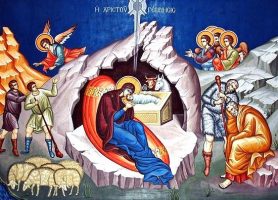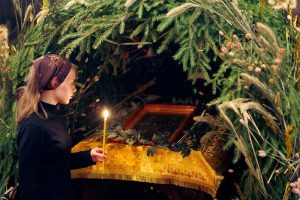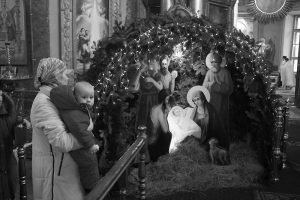Once again, the Christmas shopping season is upon us. Listening to the strains of “Joy to the World” or “Silent Night,” we frantically shop for the holidays even as we forget why we are involved in this chaos in the first place.
The entire world is in a state of unrest. Tensions run high. Yet somehow, this makes sense, for God is about to enter the world.
 Every year as I ponder Christ’s Nativity, I am reminded of “A Christmas Carol.” Scrooge is visited by three spirits from the past, present, and future who show him the consequences he faces if he does not change his ways. Because of these visits, Scrooge undergoes a spiritual metamorphosis.
Every year as I ponder Christ’s Nativity, I am reminded of “A Christmas Carol.” Scrooge is visited by three spirits from the past, present, and future who show him the consequences he faces if he does not change his ways. Because of these visits, Scrooge undergoes a spiritual metamorphosis.
Similarly, the Eastern Orthodox Church’s pre- and post-festal Christmas liturgies prepare believers for the miracle of the Nativity.
The Christmas liturgical cycle parallels the Easter season: 40 days of Lenten preparation and 40 days of post-paschal celebration. According to Orthodox tradition, Jesus returns all matter to potential goodness by receiving flesh from Mary. This restoration is completed by Christ’s resurrection.
The Eastern pre-Christmas fast period, known as Advent in the Western Church, begins on Nov. 15 (Old Calendar: Nov. 28) . During this time of abstinence, events from the past and the future are commemorated to help believers achieve a deeper understanding of Christ’s earthly mission.
The first feast is the Presentation of the Blessed Virgin Mary, celebrated on Nov. 21 (Dec. 4). Legend holds that Mary entered the Temple in Jerusalem so that she might be consecrated to the Lord’s service. By entering the Temple’s Holy of Holies, the Theotokos (Virgin Birth-giver of God) foreshadows the entrance of the Holy Spirit in the temple of her body at the time of Christ’s incarnation.
On Dec. 9 (Dec. 22), the Eastern Church celebrates the Conception of the Theotokos by St. Anna. This feast stresses that Mary was conceived in the same manner as any other human ! being. The Roman Catholic doctrine of the Immaculate Concepti! on (that Mary was conceived without original sin) is foreign to the Eastern Church. We believe Christ received our fallen nature from his mother so that it could be perfected and purified in his divine and human persona.
During these weeks, the Christmas Canon or Odes the first hymns announcing Christ’s birth are chanted during matins. These nine odes are based on Old Testament canticles and the Magnificat of Luke’s Gospel.
“Christ is born. Give him glory! “Christ has come down from heaven. Receive Him!
“Christ is now on Earth: Exalt him. O you earth sing to the Lord!
“O you nations praise him in joy, for he has been glorified. … ”
St. Nicholas of Myra, whose feast is Dec. 6 (Dec. 19), is known for his generosity and goodness. A peaceful man of the cloth, he was known for both charity toward the needy and miraculous deeds. He was zealous in his defense of theological orthodoxy, and he fought to right injustices. A true image of Christ, he is rever! ed as the prototype of Father Christmas by much of the Christian world. In many Orthodox parishes, gifts are distributed to children by St. Nicholas, whose visit is accompanied by hymns and carols.
During this Christmas fast/feast period, several other noteworthy bishops are commemorated: Ambrose of Milan, Ignatius of Antioch, Spyridon of Cyprus, Athanasius of Alexandria, John Chrysostom, Basil the Great, and Gregory the Theologian. During the final two weeks before Christmas, the church also remembers Old Testament figures who paved the way before Christ.
During the two Sundays before the Nativity, the church commemorates the genealogy of Christ. The hymns and readings of these days remember Adam; the prophets, including John the Baptist; and the Virgin. “Let us offer praise to the fathers who shone forth before and during the Law. With righteous minds they served the Lord and Master Who shone forth from the Virgin, and now they delight in unending light.! ”
Other hymns highlight the rejoicing of God’s people in! the coming of the Lord: “The Theotokos will exchange glad tidings with the honor of women: Sarah, Rebecca, and glorious Hannah. All the ends of the earth shall rejoice with them … for God shall come to be born in the flesh, granting great mercy.”
The final five days before Christmas, which are modeled after the services of Holy Week, are filled with anticipation. “Today, He who holds the whole creation in His hand is born of a Virgin. … God, who in the beginning fashioned the heavens, lies in a manger. … The Bridegroom of the Church summons the Magi. We worship thy Nativity, O Christ; Show us also thy glorious Theophany.”
All of creation races to offer gifts of love to the infinite God, born as a babe. “Every creature made by Thee offers Thee thanks. The Angels, a song. The heavens, a star. The Magi, their gifts. The shepherds, their wonder. The earth, the cave. … And we offer you a Virgin Mother.”
This unanimous offering up of all of creation to God was the spirit of peace and good will that Scrooge felt when he woke up Christmas morning. The euphoria he felt as he showered money on the townsfolk was synergy, the joy of cooperating fully with God’s work in his life.
Christmas, which was first celebrated with Epiphany on Jan. 6, was moved to Dec. 25 to Christianize the pagan feast of the Invincible Sun. “Thy Nativity, O Christ our God Has shed the light of knowledge upon the world. Through it, those who had been star worshipers learned through a star to worship Thee, O Sun of Justice, and to recognize in you the one that rises, And who comes from on high. O Lord, glory to Thee.”
The present 12-day Christmas cycle includes the name-giving or Circumcision of Christ on Jan. 1 (Jan. 14) and culminates in Epiphany or Theophany. On Theophany, the Eastern Church celebrates the manifestation of the Holy Trinity at Christ’s Baptism in the Jordan River. Water is blessed as a realization of Christ’s presence througho! ut the world. Priests go out into the homes of parishioners a! nd bless each home with the holy water.
The season ends with the Meeting of Christ in the Temple on February 2 (Feb. 15). In accordance with the Law of Moses, 40 days after Jesus’ birth Mary and Joseph traveled to the Temple to consecrate their son and present an offering. The Orthodox celebration of this feast includes the reading of the prayer or song of St. Simeon, also know as the Nunc Dimittis in the Western Church.
By February, stores will be peddling spring fashions and Easter candy, while the Orthodox Church will have just completed the Christmas cycle. Nearly three months of fasting and feasting will be complete.
Will we still be in a state of chaos? Will we find God-given peace in the coming of Christ? If we asked Scrooge, he’d answer by paraphrasing what a little friend of his said: “God’s blessed us, everyone!”
Source: St. Anthony Orthodox Church, Bergenfield, New Jersey, US
















